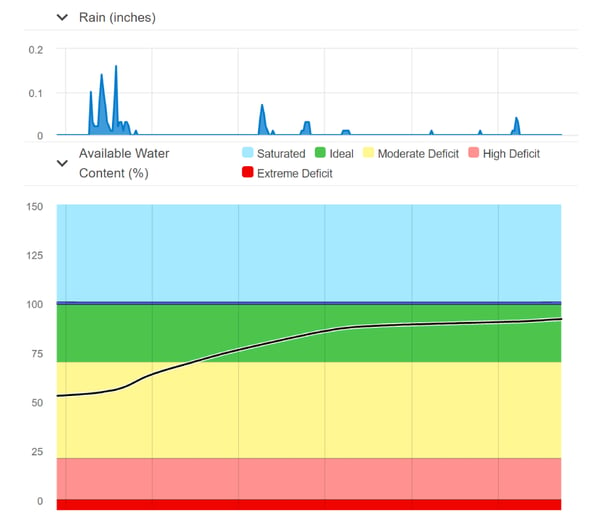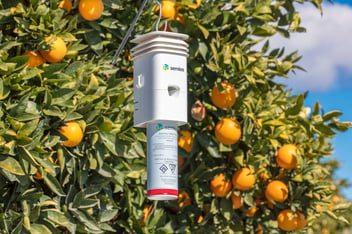This week's irrigation blog is all about rain. We love it, we hate it. We need it, but we want it to come on our timeline. Read on to see how rain can impact your irrigation planning and our rule of thumb for determining when a rain event should count as an irrigation event.

To irrigate or not to irrigate during California rainfall?
Growing up, my dad loved to irrigate during rain. Water in our canal was never enough, except when it rained and all the neighbors turned off their irrigation. Then we had enough.
Who had it right? My dad, who continued irrigating even as rain was falling? Or, the neighbors who took advantage of the wet skies to take a break from one of their many tasks?
California rain tends to usually present a feast or famine situation. Most rain events that happen during the growing season in the arid Western United States only provide enough water to erase tire tracks off of dirt roads and mess up the ripening cherry crop.
At 0.01 to 0.10” of rainfall, there isn’t enough to penetrate into the soil, it will all evaporate within hours or at most, a day after falling.
Occasionally, and I mean very occasionally in some areas, fortune may grant a full 0.50” of rain in a single storm. Let’s break that down to see what we get from it.
Factoring in your soil profile
Let’s consider a moderately heavy soil in the Pacific Northwest, a sandy loam. While this is lower on the spectrum in its ability to hold water, it is able to hold around 1.25” of water per foot.
If at the time of the rainfall, the soil was 50% depleted (ready for irrigation), it would need 0.63” of water to fill the top foot of soil.
So, with 0.50” of rain, the soil could potentially refill to just shy of a foot deep. That’s not too bad if you only need to refill the top foot, but if your soil water is depleted beyond the top foot, it simply isn’t enough. More water will be needed to refill the soil profile.
It matters how fast and how long it rains
Here is the other problem. How fast did that rain fall? Your crop can only use water if it actually enters the soil.
Often, our mid-season rainfalls that drop an amount of rain we can appreciate, do so in a relatively short time. 0.50” of water over the course of 12 hours is very different from 0.50” over the course of an hour.
When a soil’s ability to infiltrate water is exceeded, it tends to slough the extra water off. Once it starts to run, very little of what is applied afterward actually enters the soil.
If you wander outside after rain and you can see the path of water running, erosion, or the beginnings of a new canyon down your road, you can be sure that the rain came too fast and did little good for your crops.
The moral of the story? Don’t count on rain.
One of the most common questions I get after a good rainfall is, “Why aren’t my sensors showing a change in soil moisture? They must not be working.” They are working, the rain just didn’t do as much as we hoped it would.
Here's an example of what rain with and without an impact on available water content looks like on the Semios Water Management Dashboard.
Rainfall with an Impact on Available Water Content

Rainfall with negligible Impact on Available Water Content

Our rule of thumb
If you get more than a half inch over more than a day, but over less than 3 days, you should be able to count it as irrigation and see it show up on sensors. Less than that, or that amount in a shorter time period and it may as well not have happened at all.
Related Posts
Understanding Evapotranspiration (ET)



